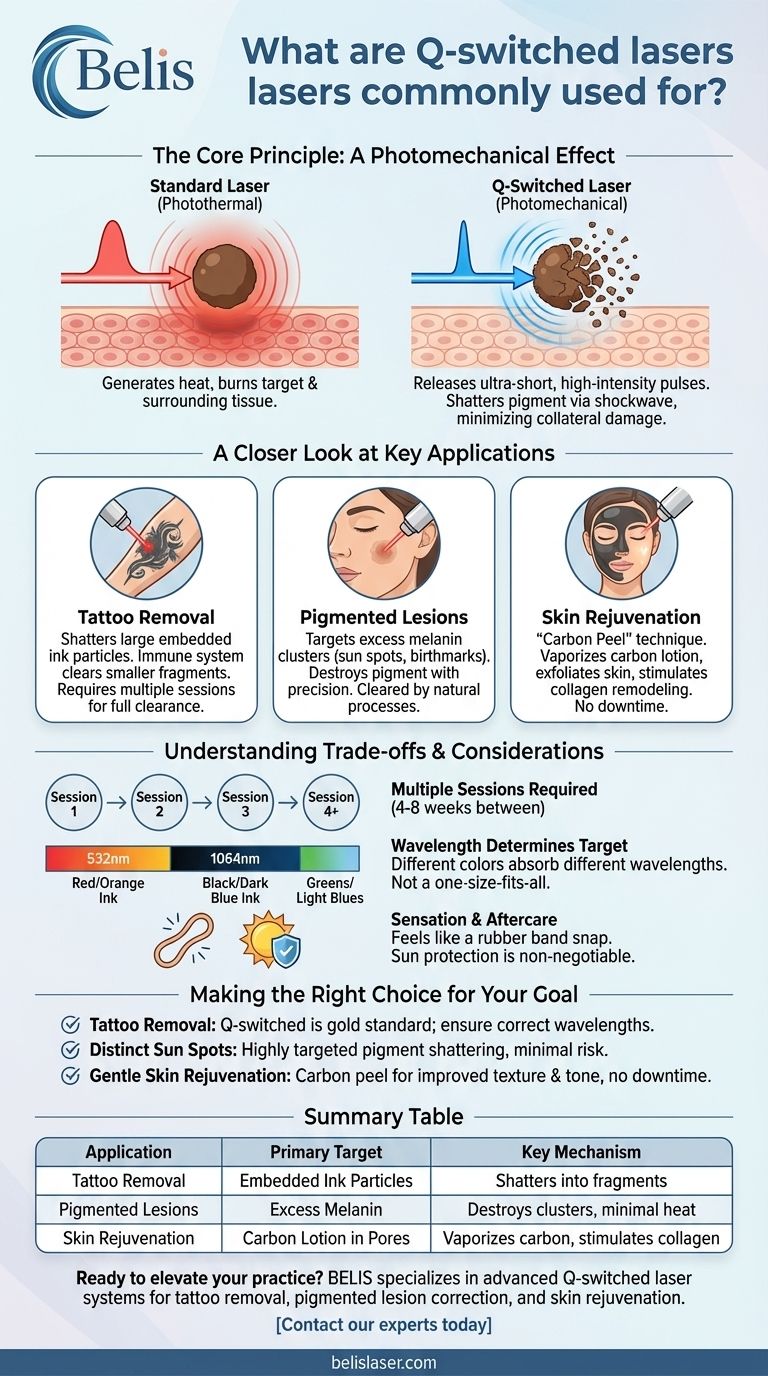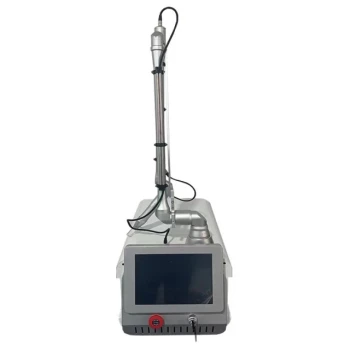At its core, a Q-switched laser is a highly specialized tool used for removing unwanted pigment from the skin. This includes its most well-known application, tattoo removal, as well as the treatment of pigmented lesions like sun spots and certain birthmarks. It is also utilized for specific types of skin rejuvenation that rely on its unique energy delivery method.
The defining characteristic of a Q-switched laser is not just the light it produces, but how it delivers it. By releasing energy in extremely short, high-intensity pulses, it shatters pigment particles with a physical shockwave, rather than slowly burning them away, minimizing damage to surrounding tissue.

The Core Principle: A Photomechanical Effect
Standard lasers often work on a photothermal principle, meaning they use light to generate heat and destroy a target. Q-switched lasers operate differently, using a photomechanical or photoacoustic effect.
What is "Q-Switching"?
Q-switching is a technique that acts like a high-speed shutter inside the laser cavity. It allows the laser medium to store a tremendous amount of energy before releasing it all at once in an ultra-short pulse, typically lasting just a few nanoseconds.
Creating a Shockwave, Not Just Heat
This rapid, intense burst of energy is absorbed by the target pigment (like tattoo ink or melanin). The absorption is so fast that the pigment particles expand instantaneously, creating a photoacoustic shockwave that shatters them into much smaller fragments.
Minimizing Collateral Damage
Because the energy pulse is so brief, there is very little time for heat to spread to the surrounding healthy skin. This makes the procedure highly precise and significantly reduces the risk of scarring and other thermal damage compared to slower-pulse lasers.
A Closer Look at Key Applications
This unique mechanism makes the Q-switched laser exceptionally effective for specific tasks where pigment is the primary target.
Tattoo Removal
This is the quintessential application for Q-switched lasers. The laser's energy shatters the large ink particles embedded in the dermis. Once broken into smaller pieces, the body's immune system can recognize them as foreign debris and gradually clear them away.
Treating Pigmented Lesions
The laser targets excess melanin in the same way it targets tattoo ink. It is highly effective for superficial, well-defined spots such as solar lentigines (age spots or sun spots) and café-au-lait macules. The shattered melanin is then cleared by the body's natural processes.
Non-Ablative Skin Rejuvenation
A popular technique known as a "carbon peel" or "Hollywood peel" uses a Q-switched laser. A thin layer of medical-grade carbon lotion is applied to the face, which absorbs into the pores. The laser is then used to vaporize the carbon, which gently exfoliates the skin, reduces pore size, and provides a thermal stimulus to the dermis that can promote collagen remodeling.
Understanding the Trade-offs and Considerations
While highly effective, it's critical to understand the realities of Q-switched laser treatments.
Multiple Sessions Are Required
Results are not instantaneous. Whether removing a tattoo or a pigmented lesion, the process requires a series of treatments. Each session shatters more pigment, and the body needs time—typically 4 to 8 weeks—between sessions to clear the fragments.
Wavelength Determines the Target
Different colors absorb different wavelengths of light. This is why a single Q-switched laser is not a one-size-fits-all solution for multi-colored tattoos. For example, an Nd:YAG laser can produce 1064nm light (for black and dark blue ink) and 532nm light (for red and orange ink), while other lasers like a Ruby or Alexandrite may be needed for greens and light blues.
Sensation and Aftercare
The treatment is often described as feeling like a rubber band snapping against the skin. Post-treatment effects typically include redness, swelling, and sometimes pinpoint bleeding or blistering, which resolves with proper aftercare. Protecting the treated area from the sun is non-negotiable.
Making the Right Choice for Your Goal
Selecting the right approach depends entirely on the problem you are trying to solve.
- If your primary focus is removing a tattoo: Q-switched lasers are the gold standard, but ensure the provider has the correct wavelengths for your specific ink colors.
- If your primary focus is treating distinct sun spots: This technology offers a highly targeted way to shatter the pigment with minimal risk to the surrounding skin.
- If your primary focus is gentle skin rejuvenation with no downtime: A carbon peel using a Q-switched laser is an effective option for improving skin texture and tone.
Ultimately, the power of the Q-switched laser lies in its ability to deliver precise, high-impact energy to shatter unwanted pigment with remarkable efficiency.
Summary Table:
| Application | Primary Target | Key Mechanism |
|---|---|---|
| Tattoo Removal | Embedded Ink Particles | Shatters ink into fragments for immune system removal |
| Pigmented Lesions | Excess Melanin (e.g., sun spots) | Destroys melanin clusters with minimal heat spread |
| Skin Rejuvenation | Carbon Lotion in Pores | Vaporizes carbon to exfoliate and stimulate collagen |
Ready to elevate your practice with professional-grade technology?
BELIS specializes in providing advanced medical aesthetic equipment, including state-of-the-art Q-switched laser systems, to medical aesthetics clinics and premium beauty salons. Our solutions are designed to help you deliver safe, effective, and profitable treatments for tattoo removal, pigmented lesion correction, and skin rejuvenation.
Contact our experts today to discover the right Q-switched laser for your clinic's specific needs and clientele.
Visual Guide

Related Products
- Q Switch Nd Yag Laser Machine Tattoo Removal Nd Yag Machine
- Pico Picosecond Laser Machine for Tattoo Removal Picosure Pico Laser
- Clinic Use IPL and SHR Hair Removal Machine with Nd Yag Laser Tattoo Removal
- RF Microneedling Machine Micro Needle Radio Frequency Machine
- Hydrafacial Machine Facial Clean Face and Skin Care Machine
People Also Ask
- What are the disadvantages of Q-switch laser? Managing Risks for Safe Treatment
- How does the Nd:YAG laser work? Unlocking Deep-Tissue Precision for Medical Aesthetics
- What is the mechanism of action of the YAG laser? Precision Cutting & Deep Tissue Coagulation
- How much does a laser tattoo removal machine cost? Choose the Right Tech for Your Clinic
- Is Q Switched Nd:YAG laser good? The Gold Standard for Tattoo & Pigment Removal



















